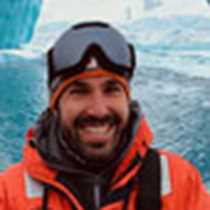Today we explored the north coast of Santiago Island, at Buccaneer’s Cove and Puerto Egas. This central island offers outstanding landscapes with high cliffs and interesting rock formations. Wildlife around this area consists of several seabird species such as blue-footed boobies, brown pelicans, and swallow-tailed gulls. We explored this island by kayaks, Zodiac rides, snorkeling, and walking along a magnificent trail. Today our guests had a blast learning about the natural history and geology of this island. We celebrated the end of this week with a farewell cocktail with Captain Mario Lomas in the lounge of National Geographic Endeavour II.
- Daily Expedition Reports
- 01 Dec 2023
Buccaneer’s Cove and Puerto Egas, Santiago Island, 12/1/2023, National Geographic Endeavour II
- Aboard the National Geographic Endeavour II
- Galápagos
Javier Cotin, Naturalist
Javier 's passion for birds and nature began as a child exploring the Pyrenees mountains with his father. The mystery that surrounds the Lammergeier silhouette triggered his curiosity and interest towards wildlife. Javier studied biology in Spain and...
Read MoreShare Report
Exploring Galápagos
VIEW ITINERARYRelated Reports
5/7/2025
Read
National Geographic Delfina
Bahía Urbina and Tagus Cove, Isabela Island
As the sun rose, we headed to Urbina Bay, a visitor site found on Isabela Island at the slopes of the marvelous Alcedo Volcano. Isabela is home to a unique morphotype of dome-shelled tortoises and arguably the most pristine island of the Galapagos. We went for a short walk, and in addition to spotting the popular giants, we also observed the evidence of an uplift event which occurred in 1954. In the afternoon, we navigated for an hour to the historical Tagus Cove, the same place where HMS Beagle once anchored. With elusive octopi, fast swimming penguins, funny looking cormorants, and breathtaking views, we finished another great day in this enchanted archipelago.
5/6/2025
Read
National Geographic Endeavour II
Isabela Island
Navigation brought us to the largest island in the Galapagos Archipelago, Isabela. Holding half of all land mass in the Galapagos, it has a diverse selection of ecosystems that we were able to visit. Urvina Bay was geologically uplifted in the 1950’s, taking two square kilometers of seafloor that was thrust upward, in certain areas up to four meters out of the water. Intertidal species were stranded inland, and we walked upon this area. Galapagos giant tortoises and land iguanas were found on our trail, and we were surrounded by Darwin finches and Galapagos mockingbirds. The afternoon brought us to Tagus Cove where we explored the surrounding waters, encountering Galapagos penguins and Pacific green sea turtles swimming among the kayakers and snorkelers. As the sun dipped below the horizon, adventurous hikers took a fast-paced hike to enjoy an incredible view of Darwin Lake and the immense island of Isabela.







